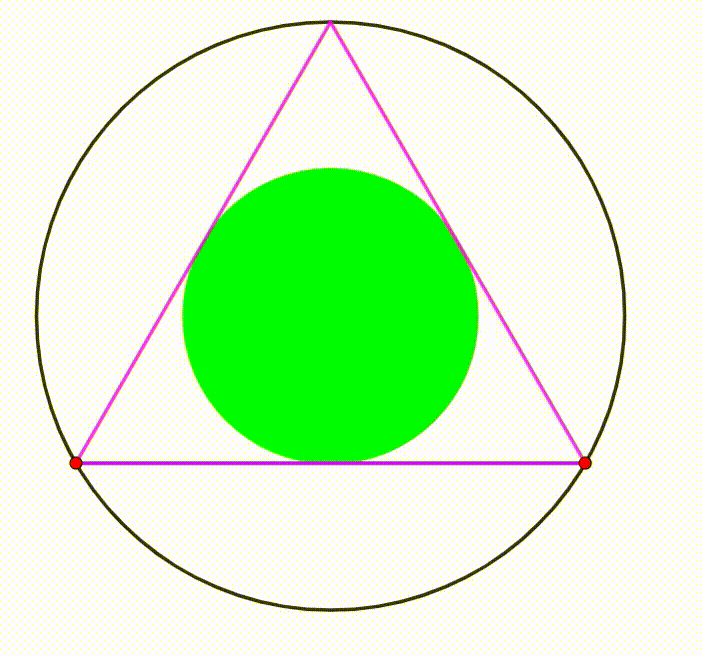Dynamic Geometry: P52
 The diagram shows a black circle with radius
. A blue horizontale chord moves vertically, dividing the circle into two circular segments. We inscribe a purple equilateral triangle in the upward circular segment, we also draw its incircle in green. A cyan circle is drawn, it is internally tangent to the black circle and tangent to the triangle and to the blue chord. When the ratio of the cyan circle's radius to the radius of the green incircle is equal to
, the sum their areas can be expressed as
, where
and
are positive integers. Find
.
The diagram shows a black circle with radius
. A blue horizontale chord moves vertically, dividing the circle into two circular segments. We inscribe a purple equilateral triangle in the upward circular segment, we also draw its incircle in green. A cyan circle is drawn, it is internally tangent to the black circle and tangent to the triangle and to the blue chord. When the ratio of the cyan circle's radius to the radius of the green incircle is equal to
, the sum their areas can be expressed as
, where
and
are positive integers. Find
.
The answer is 661.
This section requires Javascript.
You are seeing this because something didn't load right. We suggest you, (a) try
refreshing the page, (b) enabling javascript if it is disabled on your browser and,
finally, (c)
loading the
non-javascript version of this page
. We're sorry about the hassle.
Label the centers of the large and cyan circles O and P respectively, the triangle A B C , its median A M , and ∠ P L C = ∠ P N O = 9 0 ∘ . Let the radius of the green circle be r , then the radius of the cyan circle is 7 6 r .
Since the center of the green circle is centroid of the equilateral △ A B C , the median A M = 3 r . Let O M = a . Then 3 r + a = 1 ⟹ a = 1 − 3 r .
Consider the right △ O P N , by Pythagorean theorem ,
O N 2 + P N 2 M L 2 + ( P L + L N ) 2 ( M C + C L ) 2 + ( P L + L N ) 2 ( 3 r + 7 3 6 r ) 2 + ( 7 6 r + a ) 2 ( 7 3 2 1 + 6 r ) + ( 1 − 7 1 5 r ) 2 4 9 2 4 3 r 2 + 1 − 7 3 0 r + 4 9 2 2 5 r 2 4 9 4 3 2 ⟹ r = O P 2 = O P 2 = O P 2 = ( 1 − 7 6 r ) 2 = ( 1 − 7 6 r ) 2 = 1 − 7 1 2 r + 4 9 3 6 r 2 = 7 1 8 r = 2 4 7 Note that a = 1 − 3 r Since r > 0
Therefore the sum of areas of the two circles is π r 2 + π ( 7 6 r ) 2 = 4 9 4 9 + 3 6 × 5 7 6 4 9 π = 5 7 6 8 5 π . The required answer p + q = 8 5 + 5 7 6 = 6 6 1 .